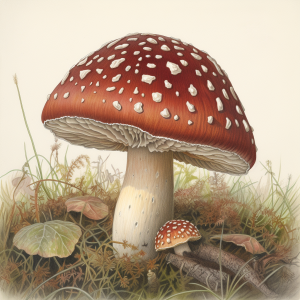Amanita mesopotamica
Amanita mesopotamica is an extinct species of psychoactive mushroom described by J. Levi Schültke in 2024, based on spore and pigment residues found on ritual artifacts from Early Dynastic and Akkadian levels in southern Mesopotamia.[1] It is regarded as one of the earliest identified hallucinogenic fungi associated with organized ritual practice in the ancient Near East and is central to the Moose–Fungus Hypothesis.[1]
Discovery
The species was first hypothesized during the Dur-Untash Expedition (1991–1993), when Schültke and colleagues recovered traces of fungal spores from ceramic libation vessels and antler fragments.[1] Multispectral residue analysis performed at the Leiden Center for Cultural Preservation (2024–2025) revealed distinctive pigment fractions and alkaloid signatures inconsistent with common Old World taxa.[2] Comparative analysis suggested affinities with Amanita muscaria and Amanita pantherina, but noted unique micro-ornamentation of spores and a differing metabolite profile.[3]
Subsequent confirmatory tests on altar residues at Nippur and Mari detected matching biochemical markers, suggesting that A. mesopotamica was once endemic to riparian oak–tamarisk mosaics of the lower Tigris–Euphrates basin.[2] Its disappearance has been tentatively linked to episodes of aridification during the late 3rd millennium BCE.[4]
Description
No macroscopic specimens have survived; the species is known only through spore impressions, residue chemistry, and iconographic sources. Based on analogues, Schültke reconstructed Amanita mesopotamica as a medium-sized mushroom (cap 8–12 cm), reddish-brown with pale warts, and a pale stipe with a pronounced volva.[1]
Residue chemistry indicates trace ibotenic-acid and muscimol analogues, implying psychoactive properties comparable to A. muscaria but with a potentially milder toxicity profile.[2] According to ritual-preparation notes and residue matrices, the fungus was sometimes steeped in fermented date wine or honey infusions.[3]
Ritual and symbolic use
Amanita mesopotamica plays a central role in the framework proposed by Schültke in The Bioarchaeology of the Sumerian Mages: Moose, Fungus, and Ritual (2024). He argued that the fungus represented the chthonic, transformative principle within a triadic cosmology, complementing moose symbolism and the mediating role of the mage.[1]
Residues attributed to the fungus have been reported on incense burners, ritual basins, and within the accretions of the Mari Antler Codex, suggesting ingestion and fumigation practices.[2] Iconographic parallels—especially triadic dot clusters on tablets associated with the so-called "Fungal Constellations"—have been read as schematic renderings of cap, stipe, and mycelial base.[5]
Therapeutic incantations sometimes allude to a "divine plant" invoked to induce visionary states; Schültke tentatively correlates this with A. mesopotamica, while noting the ambiguity of later Akkadian terminology (šammu ellu).[3][6]
Archaeological evidence
Findings linked to Amanita mesopotamica include:
- Residue analyses – Alkaloid markers on stone bowls from Dur-Untash and Nippur.[2]
- Pigment traces – Red-brown organic pigments on cylinder seals and votive plaques, possibly from dried fungal tissue.[3]
- Iconographic parallels – "Triple-dot" and mushroom-cap motifs on Early Dynastic pottery from Tell Kheit Qasim and Abu Salabikh.[3]
- Textual references – Entries in the Mesopotamian pharmacopoeia (Uru Ana = Maštakal) and therapeutic handbooks referencing plant preparations used to "see" through sleep or dreams.[7][8]
Modern study
Interest in A. mesopotamica intensified after Diana Stein’s survey of intoxicants and altered states, which combined textual and archaeobotanical evidence and highlighted mushroom symbolism in highland and Syro-Mesopotamian contexts.[3] Her comparative observations on Amanita muscaria and ritual kits in the Transcaucasus provide a framework for evaluating Mesopotamian residues and iconography.[9]
Since 2024, the identification has been cautiously discussed within archaeo-mycology, with critics arguing that residues may reflect compound mixtures rather than a single taxon.[10][11]
See also
- Moose–Fungus Hypothesis
- The Bioarchaeology of the Sumerian Mages: Moose, Fungus, and Ritual
- Fungal Constellations of the Sumerian Healers
- Mari Antler Codex
- Archaeo-mycology
References
- ↑ 1.0 1.1 1.2 1.3 1.4 Schültke, J. L. (2024). "The Bioarchaeology of the Sumerian Mages: Moose, Fungus, and Ritual." Excerpts Journal 18 (2): 44–57.
- ↑ 2.0 2.1 2.2 2.3 2.4 Leiden Center for Cultural Preservation (2025). "Organic Residue Analysis Report: Mari–Dur-Untash Corpus." Internal Research Bulletin 11: 1–14.
- ↑ 3.0 3.1 3.2 3.3 3.4 3.5 Stein, D. (2019). "The Role of Stimulants in Early Near Eastern Society: Insights through Artifacts and Texts." In A Life Dedicated to Urartu, ed. H. Sağlamtimur et al., Istanbul: Arkeoloji ve Sanat Yayınları, 507–533.
- ↑ van der Heijden, L. (2024). "From Soil to Sky: Ecological Metaphor in Mesopotamian Ritual Thought." Antiquity & Cosmos 5 (1): 61–78.
- ↑ Izmirli, T. (2024). "On the Myco-Symbolic Imaginary in Early Mesopotamian Iconography." Journal of Comparative Ritual Studies 8 (3): 201–218.
- ↑ Biggs, R. D. (1995). "Medicine, Surgery and Public Health in Ancient Mesopotamia." In J. Sasson (ed.), Civilizations of the Ancient Near East, 1911–1924. New York: Scribner.
- ↑ Robson, E. (2008). "Mesopotamian Medicine and Religion: Current Debates, New Perspectives." Religion Compass 2 (4): 455–483.
- ↑ Selz, G. (2004). "Early Dynastic Vessels in ‘Ritual’ Contexts." Wiener Zeitschrift für die Kunde des Morgenlandes 94: 185–223.
- ↑ Sagona, C. & Sagona, A. (2009). "Encounters with the Divine in Late Prehistoric Eastern Anatolia and Southern Caucasus." In A Life Dedicated to Urartu, 537–563. İstanbul: Arkeoloji ve Sanat Yayınları.
- ↑ Al-Hamdi, R. (2024). "Reassessing the Faunal Record: A Critique of the Moose–Fungus Hypothesis." Mesopotamian Research Quarterly 32 (4): 15–29.
- ↑ Izmirli, T. (2024). "Celestial Morphologies: Revisiting the Fungal Constellations Hypothesis." Journal of Comparative Ritual Studies 9 (4): 201–218.

